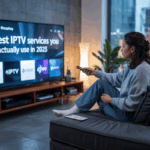In today’s high-octane digital economy, advertising isn’t optional — it’s survival. But here’s the brutal truth no one wants to put in a glossy brochure: most advertising campaigns fail. Miserably. Not because brands aren’t trying. Not because they don’t have the budgets. They fail because they play the wrong game with the wrong mindset.
If you’re serious about scaling your brand, really serious, you need to understand why most campaigns crash and burn — and more importantly, how smart brands engineer a turnaround that leaves competitors eating dust.
If you’re new to building performance-based campaigns, resources like WordStream offer an excellent breakdown of beginner pitfalls and fixes.
Let’s dive in.
Disclaimer: We don’t sell IPTV services. We don’t sell apps. We don’t take commissions.
What we actually do? We test, research, compare, and simplify. We dive into forums, scroll through tech blogs, install all kinds of apps (even the weird ones), and package everything into useful shortcuts you can trust.
We’re just a bunch of nerds obsessed with tech, doing our best to save you time and headaches. Everything we write comes from real testing and experience — no fluff, no hype, no bias.
Use it, test it, question it. We’re not here to sell — we’re here to help.
The Unfiltered Reasons Why Most Advertising Campaigns Crash
1. Lack of Strategic Clarity
Most brands jump into ads like a kid into a candy store — fast, excited, and without a plan. They focus on tactics (Facebook ads, Google Ads, TikTok influencers) without a clear strategy (who are we speaking to, what do they care about, what is our hook?).
No strategy = no direction = wasted spend.
2. Targeting the Wrong Audience
You can have the slickest creative and the most generous ad budget, but if you’re targeting soccer moms with ads about luxury sports cars, you’re flushing money down the drain.
Real winners obsess over audience insights. Not surface-level demographics — deep psychographics.
3. Weak Value Proposition
Most ads are boring because most brands sound the same. “Best quality! Lowest prices! Great service!” Yawn.
Smart brands craft a value proposition so strong, so magnetic, that ignoring them feels stupid.
4. Creative That Doesn’t Connect
Bad creative isn’t just ugly — it’s irrelevant.
Great advertising doesn’t “look good.” It feels right to the viewer. If your message doesn’t spark emotion, curiosity, or trust, you’re invisible.
5. Impatience (The Silent Killer)
The average brand expects results in a week. Newsflash: ads are not magic spells. It takes time to optimize, test, tweak, and scale.
Brands that quit after 10 days are sponsoring their competitors’ success.
6. No Real Funnel or Follow-Up
Clicks are not customers.
Leads are not loyalty.
Most campaigns die because brands have no nurturing process — no system that captures attention, builds trust, and converts gradually.
How Smart Brands Turn It Around (Without Throwing Money Away)
1. They Start with Ruthless Clarity
The smartest brands don’t just “run ads” — they engineer customer journeys. They know:
-
Who they’re targeting
-
What pain points they’re solving
-
Why their solution is uniquely better
-
Where and how their audience consumes content
Before a single dollar is spent, they have a battle map.
2. They Obsess Over Creative
Creative is not decoration. It’s the weapon.
Smart brands test multiple angles, hooks, images, headlines, and offers until something sticks — then double down aggressively.
They don’t marry their first idea. They marry the one the market loves.
3. They Build Full Customer Ecosystems
An ad that only sells is short-sighted.
An ad that introduces, educates, excites, and escalates = cashflow machine.
Smart brands build ecosystems:
-
Free content
-
Retargeting sequences
-
Tripwire offers
-
Upsells
-
Loyalty programs
-
Referral loops
If you’re looking for content inspiration for nurturing strategies, a good source like TopFirestick.com provides examples of customer-focused articles that balance acquisition and value delivery.
4. They Respect Data (Even When It Hurts)
The best marketers don’t trust their guts. They trust the metrics.
They want to be proven wrong fast so they can pivot quickly and profitably.
If the data says the creative sucks? They scrap it. If the data says a landing page is underperforming? They rebuild it.
Emotionally detached. ROI obsessed.
5. They Play Long-Term Games
A flash-in-the-pan ad campaign is fun for a dopamine hit.
A brand that builds sustainable traffic, brand equity, and customer loyalty?
That’s market dominance.
Smart brands reinvest profits into brand building while scaling acquisition.
They don’t just think about next week’s ROAS — they think about owning their category.
Real Talk: The Winners vs. The Losers
| Losers | Winners |
|---|---|
| Random Facebook boosts | Strategic omnichannel campaigns |
| Vanity metrics obsession | Profitability obsession |
| Copy-paste tactics | Customer-centric innovation |
| Emotional decisions | Data-driven decisions |
| Quit after first setback | Optimize relentlessly |
Closing Thoughts
Here’s the no-spin reality: Advertising will either be your biggest asset or your biggest expense.
There’s no middle ground.
If you’re running ads “just because you should,” you’re already bleeding money.
If you engineer customer attention, trust, and loyalty deliberately, your ads will scale your business faster than anything else on earth.
The market rewards those who respect it. It punishes those who wing it.
The question is: which one are you?






